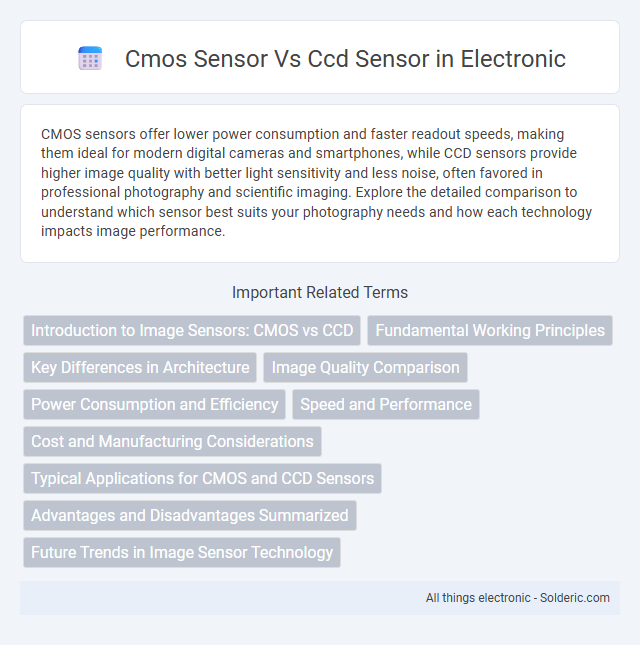CMOS sensors offer lower power consumption and faster readout speeds, making them ideal for modern digital cameras and smartphones, while CCD sensors provide higher image quality with better light sensitivity and less noise, often favored in professional photography and scientific imaging. Explore the detailed comparison to understand which sensor best suits your photography needs and how each technology impacts image performance.
Comparison Table
| Feature | CMOS Sensor | CCD Sensor |
|---|---|---|
| Technology | Complementary Metal-Oxide-Semiconductor | Charge-Coupled Device |
| Power Consumption | Low power usage | Higher power usage |
| Image Quality | Good, improving with advances | High image quality, less noise |
| Speed | Faster readout and processing | Slower readout speed |
| Cost | Lower manufacturing cost | Higher manufacturing cost |
| Sensitivity | Lower sensitivity, increasing with tech | Higher sensitivity, better in low light |
| Noise Levels | Higher noise at low light conditions | Lower noise, cleaner images |
| Integration | Easy integration with on-chip features | Limited on-chip integration |
| Application | Mobile phones, webcams, consumer electronics | Professional photography, astronomy, medical imaging |
Introduction to Image Sensors: CMOS vs CCD
CMOS sensors offer faster processing speeds and lower power consumption compared to CCD sensors, making them ideal for high-speed photography and mobile devices. CCD sensors provide superior image quality with less noise, favored in professional photography and scientific imaging for capturing detailed, high-resolution images. Understanding the differences in technology and performance helps you choose the right image sensor for your specific imaging needs.
Fundamental Working Principles
CMOS sensors convert light into electrons at each pixel using individual transistors, enabling faster readout and lower power consumption. CCD sensors transfer charge across the chip to a single output node, which offers high image quality but with slower processing speed and higher energy use. Understanding these fundamental working principles helps you choose the right sensor for specific imaging applications.
Key Differences in Architecture
CMOS sensors feature individual pixel amplifiers allowing faster readout speeds and lower power consumption, whereas CCD sensors employ a charge transfer process that moves charge across the chip to a single amplifier, resulting in higher image quality and less noise. CMOS architecture enables integration of additional circuitry such as analog-to-digital converters on the sensor chip, improving efficiency and reducing overall system complexity. CCD architecture, being more uniform, typically delivers superior light sensitivity due to its design but is more complex and costly to manufacture compared to CMOS sensors.
Image Quality Comparison
CMOS sensors generally offer improved image quality compared to CCD sensors due to lower noise levels and higher dynamic range, resulting in clearer and more detailed images in various lighting conditions. CCD sensors, while traditionally known for excellent color accuracy and uniformity, tend to consume more power and produce higher noise in low-light scenarios. Advances in CMOS technology, including backside illumination and pixel-level amplification, have significantly closed the gap, making CMOS sensors the preferred choice for modern digital cameras and smartphones.
Power Consumption and Efficiency
CMOS sensors consume significantly less power than CCD sensors due to their design, which integrates amplifiers and noise reduction circuits directly on the chip, boosting overall efficiency. Your devices benefit from CMOS technology's lower energy requirements, resulting in longer battery life and reduced heat generation during operation. While CCD sensors offer high image quality, their higher power consumption often limits their use in portable or power-sensitive applications.
Speed and Performance
CMOS sensors offer faster readout speeds and lower power consumption compared to CCD sensors, making them ideal for high-speed photography and video applications. CCD sensors typically provide higher image quality with better light sensitivity but are slower in processing and consume more power. Advances in CMOS technology have narrowed the performance gap, enabling rapid image capture with improved noise reduction and dynamic range.
Cost and Manufacturing Considerations
CMOS sensors are generally more cost-effective to manufacture due to their compatibility with standard semiconductor fabrication processes, allowing integration of additional circuitry on the same chip and reducing production complexity. CCD sensors require specialized manufacturing techniques, often resulting in higher production costs and longer development times. The lower power consumption and higher yield rates of CMOS sensors also contribute to their economic advantage in mass-market applications.
Typical Applications for CMOS and CCD Sensors
CMOS sensors are widely used in smartphones, digital cameras, and automotive imaging systems due to their low power consumption and fast readout speeds. CCD sensors excel in scientific imaging, surveillance cameras, and professional video equipment because of their high image quality and superior light sensitivity. Both technologies cater to different needs, with CMOS preferred for cost-effective, high-speed applications and CCD favored for precision and low-noise imaging requirements.
Advantages and Disadvantages Summarized
CMOS sensors offer faster processing speeds, lower power consumption, and cost-effectiveness, making them ideal for portable and high-speed imaging applications. CCD sensors deliver superior image quality with lower noise levels and better light sensitivity, favored in professional photography and scientific imaging. Your choice depends on prioritizing speed and efficiency (CMOS) versus high-quality image capture (CCD).
Future Trends in Image Sensor Technology
CMOS sensors are rapidly advancing with higher resolution, lower power consumption, and enhanced on-chip processing capabilities, making them the preferred choice for future image sensor developments. Emerging technologies like stacked CMOS and organic photodetectors promise improved sensitivity and faster readout speeds compared to traditional CCD sensors. Innovations in AI integration and quantum dot materials further drive the evolution of CMOS sensors, ensuring superior performance in diverse imaging applications.
cmos sensor vs ccd sensor Infographic

 solderic.com
solderic.com